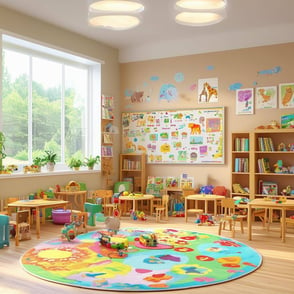Exploring the Rudolf Steiner Approach to Early Years Education
In the ever-evolving landscape of early childhood education, diverse methodologies offer a palette of choices for parents and educators eager to nurture young minds. Among these, the Rudolf Steiner approach, also known as Waldorf education, presents an enchanting blend of developmental frameworks and pedagogic principles that have sparked interest and debate for over a century. This method, with its unique philosophy, reverberates within the walls of many esteemed institutions worldwide, including several well-established schools in the UK. Let's delve into the specifics of the Steiner approach, its historical roots, and how it compares to other early years educational frameworks, such as Reggio Emilia, Te Whariki, High Scope, Forest School, and Montessori.
Historical Roots and Origins
Rudolf Steiner (1861-1925), an Austrian philosopher, scientist, and artist, founded the Waldorf education system in the early 20th century. The first Waldorf school was established in 1919 in Stuttgart, Germany, for the children of workers at the Waldorf-Astoria cigarette factory. Steiner's philosophy, known as anthroposophy, emphasises holistic development, integrating the intellectual, practical, and artistic aspects of education. The approach seeks to cultivate not just the academic prowess of children but also their spiritual and emotional well-being.
Developmental Frameworks in Core Areas of Learning
At the heart of the Steiner approach lies a deep respect for the child's developmental journey, divided into distinct phases. The early years (birth to seven) are considered a foundational period where sensory experiences and imaginative play are prioritised. Educators encourage activities that stimulate creativity and physical development, such as storytelling, art, music, and nature exploration. This period is devoid of traditional academic pressures, emphasising instead the world of the senses and nurturing the imagination.
Moreover, the Steiner curriculum integrates core areas of learning—cognitive, emotional, and physical—without compartmentalising them into conventional subjects. The learning process is viewed as a symphony of experiences, where rhythm, repetition, and routine form its essential components. For instance, a math lesson might be woven into a story or a piece of music, creating a rich, multifaceted learning experience.
Principle Pedagogic Principles in Teaching and Learning
Steiner schools are renowned for their distinctive pedagogic principles. The role of the teacher is pivotal, acting not merely as a conveyor of knowledge but as a guide who accompanies the child on their educational journey. The teacher-student relationship is nurtured over extended periods, often with the same teacher accompanying a class through several years of schooling. This continuity fosters a sense of security and trust, allowing for a deeper understanding of each child's unique needs and capabilities.
Creativity is the cornerstone of the Steiner method. Artistic activities are not seen as mere pastimes but as vital components of cognitive and emotional development. Singing, painting, and crafting are integrated into daily learning, cultivating not only artistic skills but also attention, patience, and social interaction.
Additionally, the Steiner approach emphasises the importance of a balanced rhythm in daily life. This includes seasonal festivals, regular routines, and ample time for free play, which are considered crucial for the development of a healthy child.
Comparisons with Other Early Years Specialisms
The world of early childhood education is rich with diverse methodologies, each with its distinctive flair and strengths. How does the Steiner approach stand in comparison to other specialisms like Reggio Emilia, Te Whariki, High Scope, Forest School, and Montessori?
- Reggio Emilia: Originating in Italy, this approach, like Steiner, values the whole child and emphasises creativity and the role of the environment as the "third teacher." However, while Reggio Emilia is heavily project-based, focusing on collaborative problem-solving, Steiner places more emphasis on individual creative expression and rhythmic daily routines. To find out more about the Reggio approach, read our blog
- Te Whariki: The New Zealand-based Te Whariki framework also shares a holistic view of the child, valuing cultural context and community. While both Steiner and Te Whariki emphasise a child's connection to the world, Te Whariki is more explicitly bicultural, incorporating indigenous Maori perspectives throughout its curriculum. To find out more about the Te Whariki approach, read our blog
- High Scope: An American educational model, High Scope is grounded in active participatory learning, where children plan, do, and review their activities. Unlike Steiner's more fluid and artistic approach, High Scope employs a structured curriculum with specific key development indicators to track progress. To read more about the High Scope approach, read our blog.
- Forest School: Both Forest School and Steiner education value nature deeply; however, Forest School is more focused on outdoor learning and practical skills in natural settings. Steiner, while integrating nature, also includes a significant indoor artistic element. To find out more about the Forest school approach, read our blog.
- Montessori: Developed by Maria Montessori, this method shares with Steiner an emphasis on child-centered learning. However, Montessori's approach is more structured and focuses on independence and self-directed activity, whereas Steiner emphasises collaborative learning and imaginative play without academic rigour in the early years. To find our more about the Montessori approach, read our blog.
Prominent Steiner Schools in the UK
The Steiner philosophy has found a welcoming home in the UK, with several schools dedicated to this holistic approach. Among them, Michael Hall in East Sussex and The Steiner Academy Hereford are renowned for their commitment to Steiner's principles. These institutions provide a nurturing environment that aligns with the Waldorf ethos, blending creativity with academic learning and fostering community spirit.
Conclusion
In conclusion, the Rudolf Steiner approach to early years education offers a compelling alternative to more traditional and structured educational models. Its emphasis on holistic development, creative expression, and the nurturing of a child's spirit and imagination makes it a captivating choice for many parents and educators. While it might not suit every child's needs or every family's expectations, Steiner's philosophy contributes a valuable perspective to the diverse world of early childhood education. Whether through its historical roots, unique pedagogical principles, or the harmonious blend of learning it promotes, the Steiner approach continues to inspire and intrigue those who seek to understand the full spectrum of educational possibilities for young children.

31-Dec-2024 18:11:37
Related Articles





Write a Comment